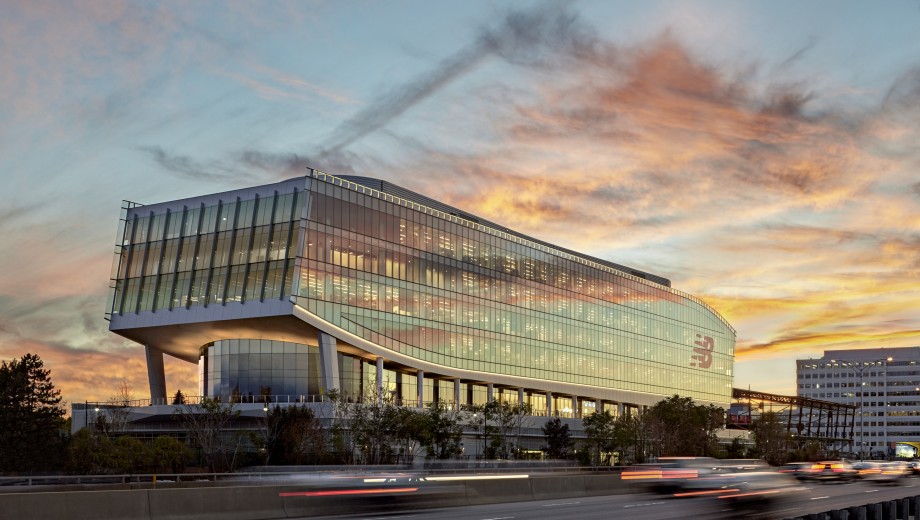Growing up, architect David Manfredi spent summers working with his father, a carpenter and homebuilder in Glastonbury, Connecticut. He liked the job—the sensation of swinging a hammer, the feeling of being outside, the satisfaction of seeing his progress at the end of each day—but never thought about it as a career.
Instead, Manfredi, AM’76, did what many self-professed book lovers do: he got an English degree, then arrived at the University of Chicago in the fall of 1975 with the intention of earning his PhD. But with a master’s degree in hand, something nagged at him. And so, not quite sure where it would lead, he made an appointment with the dean of what is now the School of Architecture at his undergraduate alma mater, the University of Notre Dame.
The conversation upended Manfredi’s plans. The dean told him “it was the moment to explore possibilities, rather than just follow the path that I thought I was on,” Manfredi recalls. He started fresh, reenrolling at Notre Dame and earning a second BA, this time in architecture.
Today he’s the CEO and a founding principal of Elkus Manfredi Architects. The firm has worked around the world, but is best known in its home city of Boston (“these days, Elkus Manfredi seemingly designs half the buildings in the city,” the Boston Globe wrote in 2018). It’s responsible for bold new additions to the skyline, such as the curvilinear, glass-walled New Balance headquarters, and projects that reflect the city’s historic character, including a renovation of the Cathedral of the Holy Cross.
For Manfredi, the long road proved to be the right one. “I never for a moment regretted the circuitous path,” he says. He wouldn’t be the architect he is today without those two formative experiences: building alongside his father, and the hours spent huddled in Regenstein with the great books.
Like his father, Manfredi gets to touch what he makes. And, like the authors and critics he studied in graduate school, he gets to flex his narrative muscles. Architects “spend a lot of our energy communicating ideas,” he explains. “Buildings tell stories, master plans tell stories. They reflect values, they try to inspire all kinds of behavior from innovation to entrepreneurship.” In the New Balance headquarters, for example, Manfredi sought to create a workspace that expressed the company’s democratic, nonhierarchical ethos. The result was a building for 650 employees that included only four private offices.
In architecture school, he wrote a paper about the relationship between American literature and American architecture, arguing that the two art forms incorporate the day’s prevailing cultural values, albeit at different scales and paces. “I’m still a strong believer that the things that shape art shape architecture—the same world events, cultural events, values.”
Manfredi has reflected on his time at the University more than usual since January 2018, when his firm was selected to design the new Woodlawn Residential Commons on 61st Street—one of several academic and research-focused projects he’s taken on in the last decade. (He’s also designed student housing for Harvard and the Ohio State University, an academic building at Rutgers, and the Broad Institute of MIT and Harvard, a biomedical research lab.)
He’s picked up a few lessons in the process. For instance, when designing science buildings, don’t skimp on the writable walls. “Scientists will write on anything they can write on,” he says. “If you don’t make enough writable walls, they’ll write on the glass in their offices or their labs. Because that’s part of the creative process for them.”
Scrawling on glass is one of many ways users blithely disregard architects’ meticulous plans. They move furniture, they repurpose rooms, they stand in areas meant for sitting, and sit in areas meant for standing. For Manfredi, that’s a feature, not a bug. “Let your user finish the space with their own activity. Then it will be what they want it to be.”
His job is, in a sense, to get out of the way, creating spaces that allow people to do their best work and that facilitate spontaneous interactions—“casual collisions,” he calls them, “because we know the best things happen when those collisions happen.”
He’s seen the value of these quick, informal conversations in his own life: in 2015, his firm moved into a new space, and Manfredi’s office moved farther from the coffee maker and the bathroom. Having to walk across the office several times a day “changed a big problem in my life, which is that I didn’t see people enough,” he told the Boston Globe. “I might get interrupted three times each trip by people who want to talk something through. I can do that in five minutes, and I don’t have to set up meetings, or say ‘Leave it for me and I’ll look at it later.’”
Small decisions about our built environments can have outsized effects on our lives and work. As an architect, Manfredi hopes he makes the right ones. After all, when you’re done with buildings, “you don’t get ’em back.”
But he does get to see them—quite a lot, actually, since he passes several of his own designs on his daily commute. Occasionally, he has the chance to visit one of his buildings and see ideas transformed into working spaces. It’s an experience he savors, because he believes a building isn’t complete until people put it to use. In the case of Woodlawn Residential Commons, set to open in the fall of 2020, that moment isn’t far off. When students arrive, full of energy and anxiety, toting posters and mini-fridges, “then,” Manfredi says, “it comes alive.”

